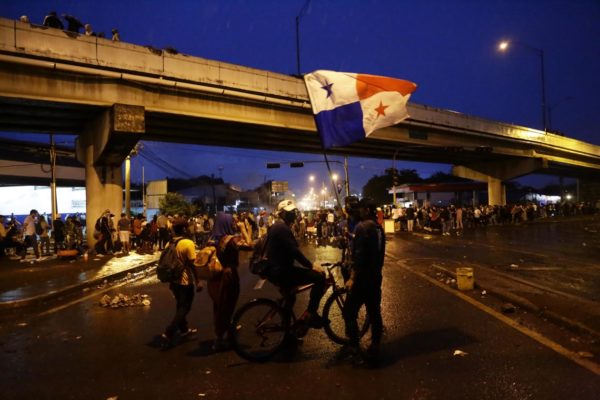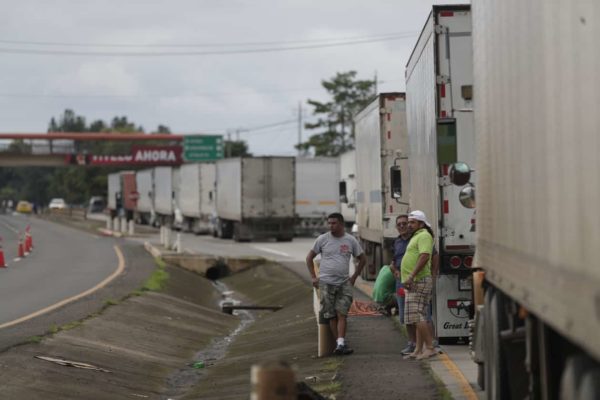Panama Experiencing Largest Protests in Decades

Thousands of Panamanians demand that the government reduce the cost of living, including gas, food, medicine and energy prices. They’re also urging a struggle against endemic corruption.
HAVANA TIMES – Panama is experiencing a wave of popular protests described as the largest in decades, demanding government intervention to reduce the cost of living. They’re also demanding a direct fight against corruption, considered the root of all evils in this country of 4.2 million inhabitants, and one of the most unequal societies of the world.
Amid shortages of food and fuel due to highway blockades, the unions and trade associations who have joined the struggle succeeded on Tuesday, July 19, in developing a unified agenda of demands. Leading their list is a real reduction in the prices of gas, food, medicines and electricity, an increase in the budget for education and a fight against corruption.
“Our country is being pulled down by a continuing situation that worsened with the pandemic. It’s a pressure cooker that’s been heating up, and that now is sounding the alarm,” Dr. Ivonne Torres, president of the civic organization Ciencia en Panama [Science in Panama], told the EFE news agency.
The protests that began on July 7 have continued, despite failed attempts from Panamanian President Laurentino Cortizo to suffocate them. The presidency approved temporary subsidies in fuel prices and in some foods, and some government “austerity” measures, although considered “insufficient” by the unions and trade associations and the organized indigenous peoples.
The different protesting groups, united in their demands, and the government, began nationally televised negotiations Thursday with mediation by the Catholic Church.
Rising cost of living
The skyrocketing cost of gas and food – which the government blames on the crisis caused by the global pandemic and the war in Ukraine – initially triggered a teachers’ strike. That protest then drew in social and indigenous sectors, and the powerful Suntracs construction union.
Saul Mendez, Suntracs leader and a former leftist presidential candidate, told EFE that while it was true that external factors had recently exacerbated the price hikes, the cost of living in Panama has been rising for years, as a result of the country’s economic model, which maximizes cooperate gains to the detriment of a population that’s ever more impoverished.
Last June, Panama registered a 5.2% annual inflation rate, an unusual rise in prices in this country with a dollarized, service-based economy, whose “salaries don’t reflect either the productivity or the dignity of its workers,” as the organization Ciencia en Panama expressed in a statement.
“Theft” of public money
The protests also raised the issue of the fight against corruption. Some of the demonstrators have shouted’ slogans against the “theft” of public money on the part of the State powers. These powers “have institutionalized corruption,” renowned Panamanian singer-songwriter and activist Ruben Bades expressed in an article.
“Have them cancel the padded contracts for the [Parliament members’] payrolls,”, Blades suggested, alleging that entire families of deputies appear on the payroll with exorbitant salaries. Jose Eugenio Stoute, a member of the organization Poder Ciudadano [“Citizen Power”], told EFE that such a reduction is one of the many measures that society is demanding, but that the government “resists announcing”.
Five trade unions demanded of the authorities: “a road map for the implementation of austerity plans that demonstrate a will for change and the “best possible management” of public resources.
“It’s urgent that the Executive branch, as well as the Legislative and Judicial branches, attack without hesitation all acts of corruption, and terminate all the privileges and the lack of transparency,” added the associations in a public declaration.
President Cortizo’s government assured that it’s fighting corruption. Cortizo responded to the insistent demands regarding the shocking increase in Panama’s debt – over 16.5 billion dollars in just three years – saying that he’s directing huge resources to social assistance programs.
Economic impact of the crisis
The agro-industrial sector stated that their sector alone suffered losses of around 500 million dollars during this crisis. Added to that is the impact on the businesses that aren’t receiving the products they need.
The protest broke out at a time when Panama is beginning to recover from the debacle caused by the pandemic. Following a 17.9% collapse of the economy in 2020, the economy recovered 15.3% in 2021 and 13.6% in the first trimester of 2022.
Moody’s risk assessment agency stated that although the government “has proposed a policy of austerity, gasoline subsidies, and the temporary expansion of certain social programs, these will have a fiscal impact in Panama,” which could cause them to fail to meet their annual goal for deficit reduction.
The subsidies “are necessary, as long as they’re focused, and with periodic reviews of their effectiveness,” Ruben Castillo, president of Panama’s National Council of Private Enterprise, told EFE.
“We can’t have a sustainable economy by increasing subsidies, but instead by increasing productivity and generating an obsession to produce jobs and attract capital. If we don’t have vigorous private enterprise, there won’t be an adequate economic recovery,” he added.

Transport trucks carrying food marooned
Hundreds of trucks from Panama and other parts of Central America, loaded with food and other products, continue to be stranded along the Pan American Highway due to the blockades. Meanwhile, the scarcity of these products has worsened in the Panamanian capital and other urban centers.
EFE was able to confirm that at least three dozen transport trucks coming from other parts of Central America have remained marooned on the outskirts of the Panamanian city of Santiago, the capital of the central province of Veraguas, located some 155 miles from Panama City.
Salvadoran driver Hector Guerra told us on Thursday, July 21, that the Central American convoy had now been stalled for three days, trapped by the protests in Panama. “We’re in the street, in bad weather; we can’t sleep peacefully, we’re not eating like we should, we don’t know if these people might decide to open our trailers. We’re very worried,” he stated.
The 30 trucks in the convoy were traveling from different parts of Central America, transporting “food, drinks and raw materials,” added Guerra. He emphasized that this delay was depleting their budget.
“A tank truck full of fuel costs US $1,000,” he noted. Since it’s a vehicle with a foreign license plate, it can’t access the subsidy the Panamanian government has approved. “All of this has gotten out of our hands,” Hector Guerra concluded powerlessly.
[Editor’s Note: One caravan of 100+ trucks carrying produce from the western part of the country finally arrived in Panama City last night 44 hours after leaving the highly productive province of Chiriqui, less than eight hours from the capital under normal circumstances.]
Read more feature stories here on Havana Times





